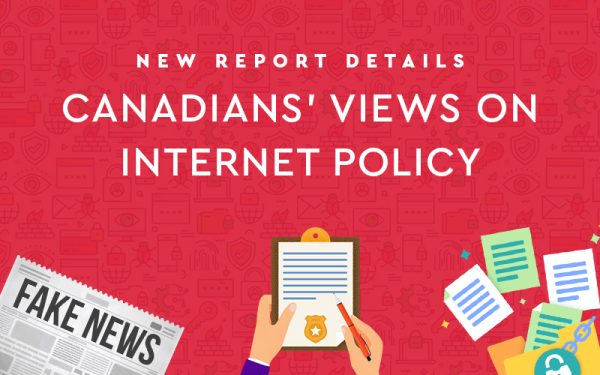The latest data on internet usage in Canada
CIRA has a mandate to promote a trusted internet—and helping Canadians understand how we actually access and use the internet is an important part of that effort.
To help advance the national conversation about the internet’s role in our daily lives, CIRA publishes its Canada’s Internet Factbook survey on an annual basis.
You can learn more about the findings of this year’s survey in the sections that follow below.
Contents

Full survey results
The 2022 Canada’s Internet Factbook survey was conducted by The Strategic Counsel in March 2022. Two thousand adult Canadian internet users (18+) were surveyed via an online panel. The goal of the survey was to identify trends in Canadian internet use.
You can find the full survey results here and a summary of the findings below.
Executive summary
A day in the life of a connected Canadian
When you wake up first thing in the morning, do you reach for your phone before you even say “good morning” to your partner? When you go to bed every night, is Siri or Alexa the last ‘person’ you speak to? For many Canadians, habits that would’ve seemed strange in 2002 have become a normal routine in 2022. That’s the power the internet holds on our daily lives.
Every year, CIRA publishes Canada’s Internet Factbook to help shine a light on how Canadians are really using the internet, and to track how those habits are changing. This year, we’re publishing a four-part blog series of the most significant insights from our annual survey of 2,000 Canadian internet users. Each blog will examine the forces at play behind moments in your daily routine.
After all, with more than half (54 per cent) of survey respondents saying they spend more than five hours online per day(up from just 36 per cent in 2016), we think most of you can relate to being online all day.
What does a day in the life of a connected Canadian look like? Picture this: while you’re eating breakfast and having a cup of coffee, perhaps you check on the latest headlines. Just over half of Canadians (52 per cent) say they usually go directly to the publisher and visit a specific news site. Others will access the news courtesy of a Silicon Valley tech giant, with 47 per cent saying the usually get their news from a Google search, while another 34 per cent take in the headlines via Facebook.
After a cup of coffee or two (or several), it’s time to go to work. For many of us that still means walking across the house instead of making a commute. It’s one pandemic lifestyle change that most Canadians would like to keep, with 39 per cent saying they’d be unwilling to work for an organization that does not allow employees to work remotely. And just wait until you learn how many of us are still working all day in our track pants in the key findings below.
Around your lunch break is a great time to scroll through social media. But the at times, toxic nature of social media has some Canadians feeling uneasy about logging in. One in four Canadians say they have experienced or witnessed harassment when using the internet. Young people aged 18 to 34 are much more likely to encounter harassment, with 37 per cent of them saying they’ve seen or experienced it online.
Once work is done for the day, Canadians may be looking to settle in for a night of Netflix. It’s still the most dominant subscriber-based content provider in Canada, with 61 per cent saying they subscribe. That hasn’t stopped other streaming services from gaining in popularity, with 40 per cent now subscribing to Amazon Prime and 23 per cent subscribing to Disney Plus. Those are significant gains for the subscriptions services since CIRA started tracking them in 2020.
When the show’s over, it’s time for bed. Considering how much of their day was spent online, Canadians must count digital sheep after their heads hit the pillow.

Key Findings
More than half of Canadians (54 per cent) say they spend over 5 hours online per day, up from 36 per cent in 2016.
One-quarter (24 per cent) of all internet users experienced or witnessed harassment online, with over a third (37 per cent) of young people (age 18 -34 years old) saying they encountered harassment in 2022.
Half of Canadians (52 per cent) say they usually get their news by visiting a specific outlet’s website. The second and third most common methods are Google searches (47 per cent) and Facebook (34 per cent).
Netflix remains the dominant streaming platform with six in 10 subscribing (61 per cent). Amazon Prime continues to gain in popularity with four in ten subscribing, compared to one in four in 2020.
Most remote workers (59 per cent) usually wear athletic clothing with nearly a third (30 per cent) saying they wear sweats, shorts, or hoodies every day, and about the same number (29 per cent) saying they do so most days.
You can find the full survey results here.

Blog series
This year, CIRA is publishing a series of blog posts based on the findings of the 2022 Canada’s Internet Factbook report.
Below you will find links to each piece in the series as it is published every Thursday of the month:
-
Canadians slowly move away from ‘toxic’ and ‘addictive’ Facebook
- ‘Netflix and chill’ isn’t that simple in 2022
- New data shows what Canadians want as offices re-open country-wide
- Is Big Tech hurting Canadian small businesses? – coming June 23





